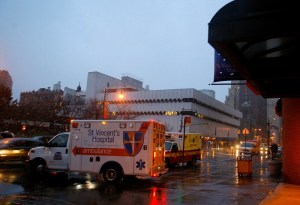 Greenwich Village has been clamoring for a new hospital ever since St. Vincent’s closed nearly a year ago. Now, with the news that North Shore-LIJ is poised to open an emergency care facility in the next few years—no major trauma unit, no in-patient care—while the Rudins get to build their condos across the street, the reaction has been about what one would expect from Jane Jacobs’ notoriously cranky neighborhood.
Greenwich Village has been clamoring for a new hospital ever since St. Vincent’s closed nearly a year ago. Now, with the news that North Shore-LIJ is poised to open an emergency care facility in the next few years—no major trauma unit, no in-patient care—while the Rudins get to build their condos across the street, the reaction has been about what one would expect from Jane Jacobs’ notoriously cranky neighborhood.
“Some folks didn’t like the idea at all because it falls short of replacing a full-service hospital,” Bob Gormley, district manager for the local community board, told The Observer. Last night, the board was to hold a hearing discussing a survey of the community’s health needs, but that got overshadowed by the North Shore/Rudin deal. Were those needs met? Not yet. “Other people are taking a wait and see approach,” Gormley added.
The reaction was much the same from Council Speaker Christine Quinn, whose district includes the Village, per a statement released by her office.
For over 150 years, generations of New York families on the West Side of Manhattan have been served by St. Vincent’s. The closing of our hospital is a tragedy that has created a hardship for both local residents and local businesses. My colleagues, the community and I have been fighting for a true replacement for St. Vincent’s, most recently sending a letter to the chief restructuring officer urging that a full service hospital and emergency room be included in any future plans for the site.
We have not yet been fully briefed on the proposal from Rudin and North Shore, but will be in the near future. While we look forward to learning the full details of the plan, I am encouraged by the commitment of both North Shore/LIJ and the Rudin family to working with local stakeholders to ensure that all the needs of the West Side residents are met.
The reaction from preservationists was equally ambivalent, even as it meant the salvation of the unusual O’Toole Building, a city landmark that St. Vincent’s was going to tear down and replace with a 300-foot tower. “I’m sure many people are relieved that the plan for the enormous tower on the O’Toole site appears to be off the table,” Andrew Berman, head of the Greenwich Village Society for Historic Preservation, wrote in an email.
Berman is still unhappy with the Rudins’ plan for 300 condos in four old and four new buildings on the old St. Vincent’s campus, though. “What happened previously with St. Vincent’s was tragic—in the incompetence of St. Vincent’s administrators and in public officials who were asleep at the wheel in never questioning St. Vincent’s financial figures. I sincerely hope that as this latest plan moves through what must be a lengthy and rigorous public approval process for zoning changes, there is deeper and more attentive oversight.”
But what are the chances the community could get much more—or less, for those who oppose the out-sized project? The difficulty of running a hospital in New York is well-documented. It is part of the reason St. Vincent’s went out of business and part of the reason no one has rushed in to take its place. Meanwhile, there is the matter of satisfying St. Vincent’s creditors. By allowing North Shore-LIJ into the deal, instead of simply selling its valuable Village real estate on the open market, St. Vincent’s is potentially making less off the deal. Yesterday, the restructuring officer said the deal offered a quicker and more certain outcome, which is why the creditors approved it. It is also quite the windfall for the Rudins, who are saving $50 million on the deal.
It was hard enough getting to this point.
Even if this were not the Village, a monumental fight—to revive a hospital, to build a condo complex, to define some notional sense of neighborhood identity—seems inevitable. But this is the Village, so the fight is bound to drag on like the last one, jeopardizing health care for the neighborhood once again.



